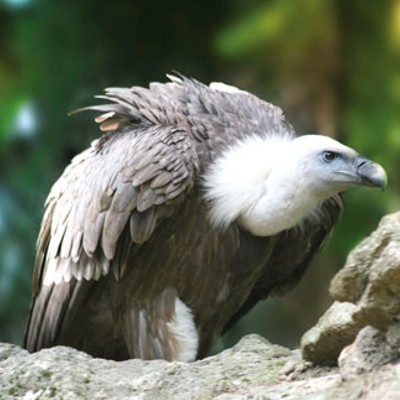Griffon vulture - Gyps fulvus
Name: Gyps fulvus – griffon vulture
Appearance: It has a relatively small head which it keeps lowered in flight. Its head and neck are covered only in white down, which is an adaptation to their eating habits. When tearing food deep from the inside of the animal, feathers would stain and stick together. Its beak is very strong and adapted to tearing the meat from the carcass. The legs are adapted to walking (not to catching the prey), and long, wide wings for long cruising on air currents while foraging.
Body length: about 100 cm
Wingspan: about 280 cm
Body weight: 7 – 10 kg
Nutrition: vulture
Number of eggs laid: 1
The griffon vulture is a big vulture that inhabits the Iberian and Balkan Peninsulas, parts of North Africa, Asia Minor, Caucasus, and southwest parts of Asia. The number of overall population is estimated at 9 000 couples (www.ec.europa.eu), while the number on the Balkan Peninsula in 2019 was estimated at 445-565 of nesting couples (Dobrev D. et al., 2021).
It inhabits wide and open areas with poor vegetation in mountain and Mediterranean areas, with canyons and inaccessible cliffs that are suitable for nesting. The griffon vulture spends most of the day resting on the rocks and cliffs, and the rest of the day flying in search of carcass.
It feeds only on dead animals, usually on big mammals and it never attacks the living prey. They usually eat the entrails of the dead animals. They cut a round hole in the abdominal wall of the carcass, and stick their long neck through it as deep as possible. They swallow parts of the intestines and internal organs without pulling their heads out of the carcass.
They make loose colonies and are usually faithful to their permanent residence. They can often be seen flying in flocks of several individuals. The griffon vultures are very noisy birds, that communicate by using a wide range of vocalization, such as hissing and grunting as they feed.
They build their nests as couples, in rock crevices and on cliffs. They bend their up to one-meter tall nests from branches, wicker, leaves, grass and sheep’s wool and cover it inside with down. Over the course of January or by the beginning of February, the female lays one egg, which is brooded by both parents. After the little bird learns to fly and look for food by itself, it becomes independent and leaves for its five-year journey. The bird usually leaves for this journey by the end of summer, in August or September. After five years of wandering and reaching its sexual maturity, the bird returns to the colony and begins looking for its partner. It usually happens in October when the wedding flights begin. After finding their partner once, they stay with it till the end of their lives – they are monogamous.
The two most important colonies of the griffon vulture in Balkan are in the Special Nature Reserve Uvac (Republic of Serbia) that has about 110 nesting couples and the Special Ornithological Reserve on the island of Cres (Republic of Croatia) that has about 50 nesting couples. On Cres, in the place called Beli, there is a “Centre for Visitors and the Recovery Centre for Griffon Vultures” where hurt vultures and young ones, that end in the sea during their test flights, recover. After the recovery, the birds are released into the nature. Some individuals are equipped with special GPS devices, which provide valuable data on their movement.
Small number of the population, poor reproductive potentials and relatively long period of gaining sexual maturity make these birds very sensitive to the changes in their habitats. The drop in the population numbers was strongly influenced by hunting, poisoning, shift to intensive industrial animal husbandry in closed barns.

